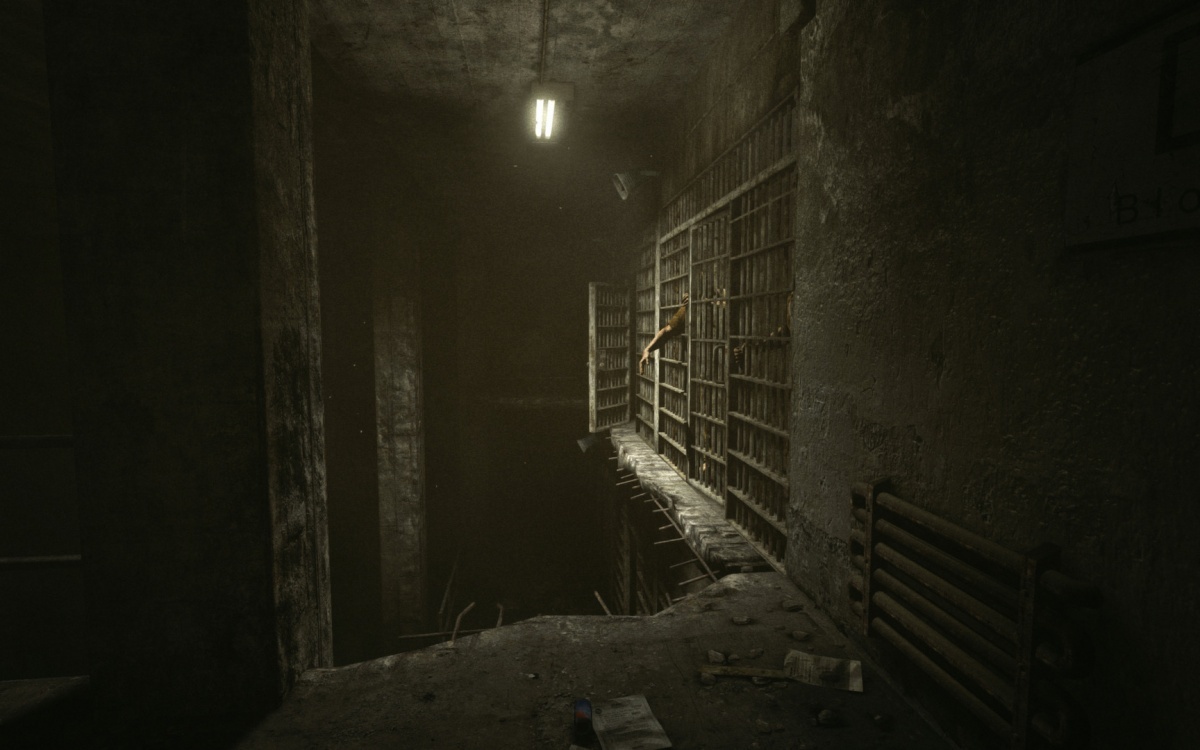Outlast: Bundle of Terror (Nintendo Switch) Review
By Coller Entragian  04.03.2018
04.03.2018

The Switch's specs may not be the highest, yet Nintendo managed to find a sweet spot when designing the console that had a decent balance of power and affordability. While id Software's Doom (2016) port - as managed by Panic Button - was a feat thought impossible, it got every developer's heads turning. It wasn't the best version, but it was very playable and impressive that so much of its essence was translated on Nintendo's glorified tablet. With the standard set, others would try to get their advanced 3D games onto Switch. Outside of both Resident Evil: Revelations and its sequel, quality horror on Switch has been poorly represented... that is until Red Barrels nonchalantly dropped Outlast: Bundle of Terror. The doctor is in and Cubed3 pulls on some rubber gloves to probe and prod to see if the Switch port of Outlast should be released into society or if it should be thrown into a padded cell.
When Outlast first came out, it was in lieu of the horror masterpiece Amnesia: The Dark Descent, one of the first and best examples of a survival horror game where the protagonist is completely defenceless. Red Barrels sought to streamline the formula that Frictional Games already perfected, all while implemented some real cutting edge visuals courtesy of the Unreal Engine 3. Red Barrels does house some real talent in its art department because Outlast was, and still is, a very good looking game, a trend that would carry on into the sequel. For some, Outlast may be seen as a horror title designed for the lowest common denominator; a game that relies heavily on jump scares, absurd gore and maybe bait for Internet personalities like Pew-die Pie. The thing is that basically all of this is true, but that does not mean Outlast is bereft of quality.

Outlast has a premise that has a lot of great ideas. Some are executed amazingly and some fall flat on their face. The idea of a mad house being taken over by the mad is a classic horror trope and here it is made even more insane thanks to nightmarish human experimentation done by the Murkoff Corporation. The "variants" are the inmates now horribly mutilated and disfigured beyond a point where they barely resemble a human being, serving as the general threat to Miles. It is impressive how many uh... variants there are of these wretched creatures. The artists have crafted a sizeable cast of these monsters, what with some of them missing limbs or facial features, and skin that looks like melted cheese. They all have pretty great designs, it's just sometimes the limits of Red Barrels becomes apparent when the variants' animation does not match what they are expressing and they stop feeling like psychos and come off more like automatons.
Probably the biggest follies of Outlast are that it just has no restraint and is too eager to throw everything at the player too early and too quickly. It is not as bad as it was in Outlast II where desensitisation kicks in about five minutes in. Red Barrels really needs to not underestimate its audience, which couldn't be more evident early on where some of the first horror imagery is a man impaled on a stake, Cannibal Holocaust-style. When something this horrible is the start of the game, the only place the developer can go is to try to top that and that is why Outlast rarely feels scary, just absurd and over the top. When Silent Hill 2 begins, it takes an unusually long time for anything to happen to James. The game begins with a long walk - a walk that feels so scary because the entire time there is anticipation of something really bad going to happen. It was nerve wracking and everyone loves it. Even when Miles is being chased by variants, the music is a comically intrusive blaring of brass instruments that is shocking at first but quickly becomes eye-rolling. The point is, horror needs some build-up. Do not show the shark in the first scene.

The gameplay in Outlast can be polarising for some since Miles is extremely limited in what he can do since his hands get mutilated early on by the game's best character, Dr. Trager. All Miles can do is hide, climb on scripted surfaces, and rely on his camcorder's night vision mode. With the game's short play time, the designers have managed to get quite a bit of mileage out of Mile's move-set and do not waste anything. It is the core gameplay and mechanics that are Outlast's strongest asset, outside of its visuals. Unfortunately, the developer undercut what would be some excellent game design, where people would have to do some believable problem solving, by including on-screen prompts that explain exactly what needs to be done. It is infuriating that this cannot be turned off in such a late version and suggests that Red Barrels over did its focus group testing.
The best sequence in the entire game that plays to all its strengths is everything involving Dr. Trager. This guy is a flawless baddie in every possible way: from his design, voice acting, line delivery and, especially, how he is implemented into the gameplay. Miles has to avoid him in an area that best suits Outlast's limited AI that has just the right amount of areas to hide and be chased. It's one of the most thrilling parts and his disturbing audio cues are enough of a hint that he doesn't feel cheap when he manages to slash Miles. It is a shame that Dr. Trager gets used so briefly when someone as unimaginative as Chris Walker is so overused throughout the adventure. At times, it feels like this goofy pig-man was a placeholder for some other freaks but was left in because somehow some tester thought he was scary. The included DLC, The Whistleblower, does manage to maintain some of the finer qualities experienced in the core experience, but in a much more concise and insane trip. In a way, The Whistleblower serves as a true final act to Outlast's underwhelming and bewildering final moments with the wall-rider.

When Outlast made its jump from PC to PlayStation 4 and Xbox One, the translation was one to one. Everyone who owned those consoles got to enjoy the ultra-violent romp through the halls of Mount Massive Asylum running at a very smooth 60 frames per second with a crisp 1080p resolution. On Switch, it was expected that Red Barrels would have to make some compromises, like Panic Button did with Doom. However, in spite of the limited technology, side by side this is a very close match when compared to the higher end versions of Outlast.
The most important aspects that defined Outlast are intact and only those who are deeply familiar with the other versions will be able to notice any difference. Red Barrels had to cut the frame-rate in half to maintain some level of visual parity with the other console ports. Frame-rate is the most important aspect of gameplay since it is tied directly with user-control, playability, and responsiveness and anyone who has played this on all previous platforms will feel the difference. Outlast's control and feel had a very distinct weight thanks to the fact that the player-character, Miles, actually had a fully realised 3D-modelled body that had animation to it and would react to geometry. For Switch owners who never played Outlast, the downgrade to 30fps may not be much of an issue because the gameplay is cantered on navigation and reasoning, not skill-based action. Anyone who already owns this on other platforms does not have much incentive to have it on Nintendo's Switch; it is the same game as it has ever been and it is still very lacking in replay value.

Cubed3 Rating
Very Good - Bronze Award

Over the years, Outlast has aged well thanks to its production design and ultra-violent spectacle. The simple act of hide-and-seek is still engaging and the adventure's length does not overstay its welcome, something that hurt the overly long sequel. Mount Massive Asylum is a memorable and grisly place and the wide cast of maniacs to meet in the core game and DLC chapter leave a lasting impression. This is a very linear horror game that is heavily scripted and is elevated thanks to the imaginative scenario. There are tons of weapon-less horror games these days and more often than not they tend to be more annoying than scary. Outlast is one of the few that just barely gets by without irritating too much. Perhaps it's because of the brevity and pacing of the game that keeps things tense and exciting so its more obvious shortcomings become much less apparent.

![]() 7/10
7/10
![]() 0
(0 Votes)
0
(0 Votes)
 Out now
Out now  Out now
Out now  Out now
Out now  Out now
Out now Comments
Comments are currently disabled

 Sign In
Sign In Game Details
Game Details Subscribe to this topic
Subscribe to this topic Features
Features







 Top
Top

